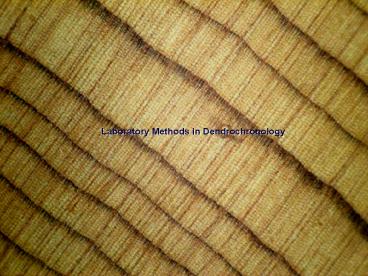Laboratory Methods in Dendrochronology - PowerPoint PPT Presentation
1 / 18
Title:
Laboratory Methods in Dendrochronology
Description:
Lay out all cores in their straws so they can air-dry. ... Movable stage micrometer with trigger. Digital display. PC running measurement software ... – PowerPoint PPT presentation
Number of Views:101
Avg rating:3.0/5.0
Title: Laboratory Methods in Dendrochronology
1
Laboratory Methods in Dendrochronology
2
- Now, lets take our wood samples back to the
laboratory - Pre-process our cores
- Lay out all cores in their straws so they can
air-dry. - Once dry, select a core and write its ID on a
core mount (both sides). - Carefully remove the core from the straw
theres a right way and a wrong way to do this. - If the core is in pieces, ensure that all pieces
are in their correct order and in their correct
alignment! - Lay the core alongside the core mount and place
glue in the groove of the mount the length of the
core.
3
- Mount your core properly!
- The core must be mounted with its cells
vertically aligned, i.e., straight up and down,
similar to how they were positioned originally in
the tree. - If the core is mounted improperly, you may have
ruined any chance of the sample being used,
because - if the core is mounted with the cells at an
angle or horizontal, the ring boundaries will not
be distinct. - First, inspect the core and find the shiny
sides. These are the sides of the core. Why does
a core have shiny sides?
4
Individual wood cells
Shiny side!
Shiny side!
5
- Mount your core properly!
- Second, inspect the ends of the core to verify
your evaluation. The ends of the core will
clearly show the alignment of the cells. - Press the core into the groove. Excess glue is no
problem. - Tape the core down onto the mount firmly at both
ends and in the middle of the core.
6
- What if your core is twisted?
- The sample must be mounted with the cells
vertically aligned. Some samples, however, may be
twisted. This is common. - If the core is only slightly twisted, you can
simply break the core into two or three pieces
and mount these correctly. - If the core is badly twisted (many turns), you
have to steam the core while simultaneously
untwisting it gently. Dont have to do this too
often.
7
- Measuring the ring widths
- Preferably should be done after you have
crossdated your samples. - If the rings are not problematic, you can measure
your cores first and then crossdate them
statistically. - Total ring width is only one physical property of
a tree ring we can measure. What others can we
measure?
8
- Measuring the ring widths
- Four parts to a measuring system
- Movable stage micrometer with trigger
- Digital display
- PC running measurement software
- Stereozoom boom-arm microscope with crosshair
reticule and light source. - This is NOT cheap. Basic system 3,000 2,000
1,500 200 6,700.
9
Advanced measuring system
CCD camera
Microscope
21 TV monitor
Light source
Movable stage
Digital display
10
- Measuring the ring widths
- Crosshair guides you from one ring boundary to
the next. - Make sure you measure perpendicular to the ring
boundary, always! - Turn the handle on the stage from one boundary to
the next. - Hit the trigger to record the measurement.
- MeasureJ2X most popular software for measuring.
Java based, requires Pentium PCs or Macs. - Measures to the nearest 0.01 mm or 0.001 mm
(preferred).
11
- Sometimes you have to physically move or relocate
the core to ensure that you measure the width of
the ring perpendicular to the ring boundaries.
12
- Imaging Systems the future of dendrochronology.
13
- Finally
- Measurements must be archived in several
locations. - All tree-ring measurements are also archived at
the International Tree-Ring Data Bank of the
World Data Center for Paleoclimatology (part of
the National Climatic Data Center) in Asheville,
North Carolina.
14
- Crossdating tree rings
- Consumes the majority of time learning about
tree-ring dating. - The more you do it, the better you become.
- Revolves around pattern recognition.
- Three basic techniques
- Graphical techniques then
- Statistical techniques, which lead to
- Memorization techniques
15
- Crossdating tree rings
- Graphical techniques
- Two techniques
- Skeleton plots (favored in the U.S.)
16
- Crossdating tree rings
- Graphical techniques
- Two techniques
- Alignment plots (favored in Europe)
17
- Crossdating tree rings
- Remember the ultimate goal you must start
memorizing which rings are particularly narrow or
which have noteworthy properties. - Other properties
- very wide rings
- frost rings
- thin latewood rings
- light rings
- rings with resin ducts
- false rings
18
- Crossdating tree rings
- Lets try crossdating via skeleton plots by
visiting Dr. Paul Sheppards excellent
educational web site at the Laboratory of
Tree-Ring Research, University of Arizona in
Tucson































